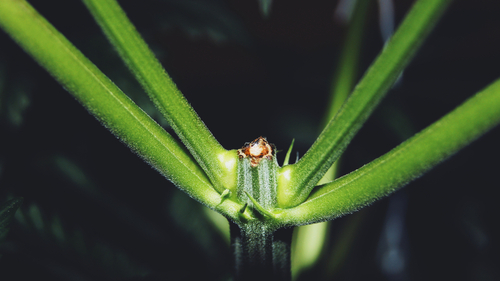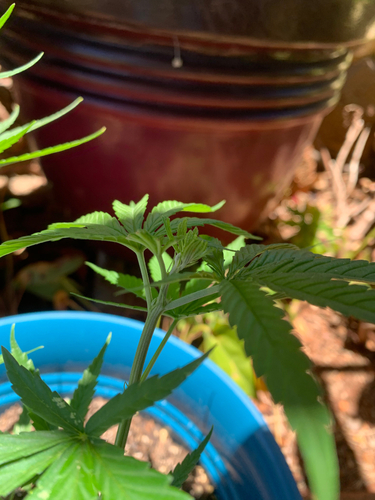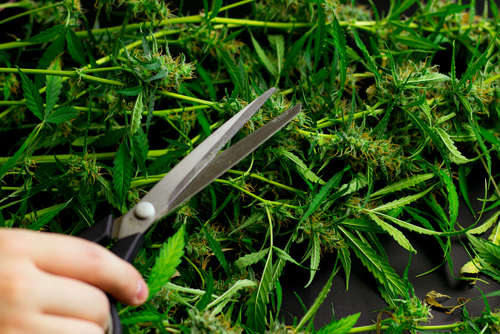No matter what weed strain a cultivator plants, their main goal is the same: Produce the most cannabis in a decent amount of time. While you don’t need to train cannabis plants to get solid results, you won’t experience the highest yields without using at least one training technique.
In plant cultivation, “training” refers to methods that put deliberate stress on your strains. Just as a good coach pushes athletes to achieve their peak performance, proper training will encourage cannabis plants to grow the max possible buds during flowering.
Topping vs. FIMming — An Overview Of These Popular Cannabis Training Techniques
There are dozens of training techniques, but topping and FIMming are two of the most widely discussed. Both of these high-stress methods are similar, but there are distinctions to keep in mind. Anyone interested in naturally increasing their weed yields should consider adding topping or FIMming to their cultivation strategy.
The Traditional Method: Topping 101
Of these two cannabis training methods, topping pre-dates FIMming. In fact, FIMming is technically a variation on topping. So, before exploring how FIMming works, it’s best to get a grounding in how to top a cannabis plant.

The word “topping” refers to cutting the “top” cola off your cannabis plant. Typically, people wait till their cannabis plant has about five nodes in the vegetative stage before topping. With a shart and sterilized pair of scissors, locate two offshoots under the top node. Cut off the main stem just above these “axillary buds.”
If you didn’t top your cannabis plant, the central cola would enjoy all of the light and grow upwards in a “Christmas tree” structure. Topping allows light to penetrate these two auxiliary buds, instantly creating two central colas. Not only does this double your yield, it helps your cannabis plant more laterally. Your topped cannabis plant won’t reach as high as an untrained plant, which is excellent news for people with limited grow space. Bushier cannabis plants tend to be easier to manage than those that grow straight up.
You can repeat topping on the two new main colas to create four main bud sites. After your plant has recovered and these nodes start to develop, repeat the same method as before. Just ensure your strain is strong enough to handle the stress of a second topping session.
How Is FIMming Different From Topping?
Allegedly, “FIMming” was created when a cannabis grower accidentally “topped” their plant far above the axillary buds. According to most accounts, “FIM” is an acronym for the phrase “F*ck I missed.” Interestingly, cannabis cultivators noticed that FIMming produced just as good, if not better, results than a classically topped cannabis plant.

If you want to FIM your plant, your goal shouldn’t be to remove the entire top of your plant. Everyone has a different opinion on how much you should take off when FIMming, but it’s best to remove about 75% between the top cola and the axillary buds.
While you could use sterile scissors for FIMming, some people prefer to “pinch” their cannabis plant with their fingers. In fact, there’s an offshoot of the FIMming technique known as “pinching.” To do this, you only have to remove the top growth above the main stem with your fingers. Just be sure to wash your hands before using this method to avoid transferring bacteria to your plant.
Similar to topping, you should notice extra cola sites growing off the sides of your cannabis plant after FIMming. In some cases, you may notice four or five colas appear from a successful FIM. There’s no rhyme or reason for how many colas grow after FIMming, and some growers have reported as many as seven colas appearing after one cut.
Is FIMming Better Than Topping?
Since FIMming often results in higher yields, it may seem like the obvious choice compared with topping. However, choosing between topping and FIMming is primarily a matter of personal preference. There aren’t many scientific studies examining the benefits and drawbacks of topping vs. FIMming. So, if you’re new to this field, it’s best to read through recommendations from experienced cannabis cultivators, especially regarding your favorite strain.
In general, FIMming is “less stressful” than topping since it cuts less of the plant. Also, as previously mentioned, FIMming may result in higher yields depending on how your plant reacts to it. Thirdly, since FIMming is technically a “mistaken top,” it tends to be more forgiving of slight errors.
While topping requires more precision, it’s more reliable than FIMming. You can predict your harvest more accurately if you get your topping strategy right. In some instances, cultivators may prefer the relative reliability topping provides.
Also, some cultivators just feel more comfortable topping rather than FIMming. It may take some experimentation with both of these methods on different strains to figure out which technique is the right fit for your grow strategy.
Will Topping Or FIMming Damage My Cannabis?
Topping and FIMming can cause irreversible damage to your cannabis plant if you’re not careful. Please remember these are both “high-stress” training techniques. No matter how quickly and cleanly you make your cut, you will put extra pressure on your cannabis plant. If your cannabis plant is weak, there’s a good chance it won’t survive topping or FIMming.
Please carefully evaluate your cannabis plant for signs of weakness, such as yellowing leaves, stunted growth, or light burn. Also, be sure to read about any special considerations regarding your strain. For instance, if the strain you’re trying to grow has a history of turning into a hermaphrodite, the stress of topping may cause it to “herm out” during flowering. Only use topping or FIMming if you’re 100% sure your strain is healthy and highly resistant to stress.
Also, please sterilize your equipment before you top or FIM your plants. Using dirty scissors or fingers when snipping your cannabis could transfer harmful bacteria to your plant and lead to severe infections.
When’s The Best Time To Top Or FIM Cannabis?
Always top or FIM your cannabis in the mid-vegetative stage. Most cultivators recommend waiting till your plant has four or five healthy node sites before using either technique. You need your plant to be young enough to have the strength to bounce back after one of these high-stress training techniques.
Please keep in mind that topping or FIMming cannabis will extend your growth cycle. Be sure to budget extra time in the vegetative stage before switching to a flowering light schedule.
Can You Top For FIM Autoflowering Strains?
Topping and FIMming are too extreme for autoflower strains. Since you can’t keep an autoflower in vegetation indefinitely, you can’t ensure it will have enough time to recover from these procedures before switching to flowering. However, you could look into low-stress training techniques like bending to get higher yields from your autoflower strains.
For more details on how to grow autos, be sure to check out this previous International High Life post.
Don’t Feel Comfortable With Topping? Consider Cannabis Bonsai!
Topping and FIMming can be intimidating training techniques, especially if you’re new to cannabis cultivation. Although many people have great success using these strategies, many low-stress training methods can produce high yields. For instance, Screen of Green (ScrOG) uses trellises to gently flatten your plants to increase bud production. Bending your stems with string is another form of training that exposes more bud sites to your light source.
To learn more about how to bend cannabis, be sure to read our previous post on “Cannabis Bonsai.”

Leave a Reply